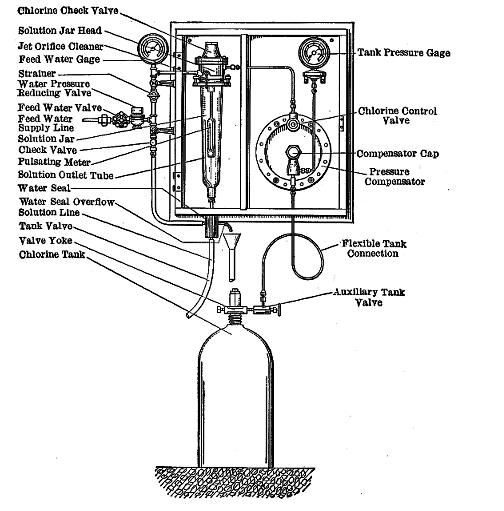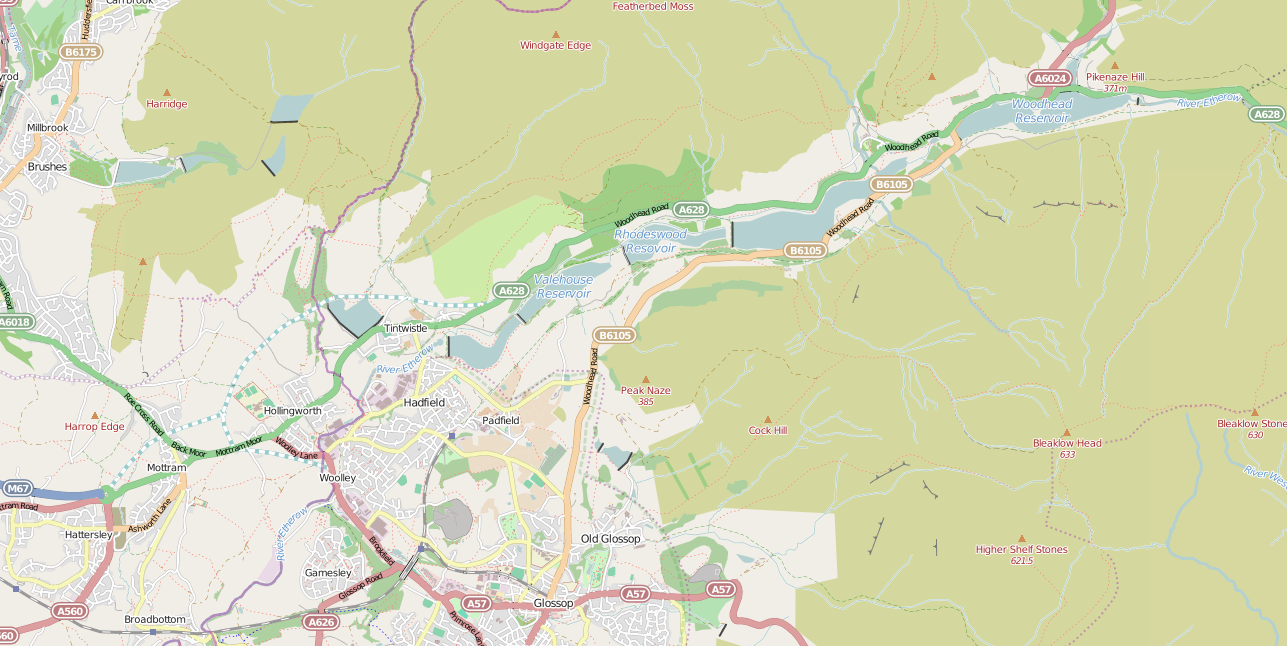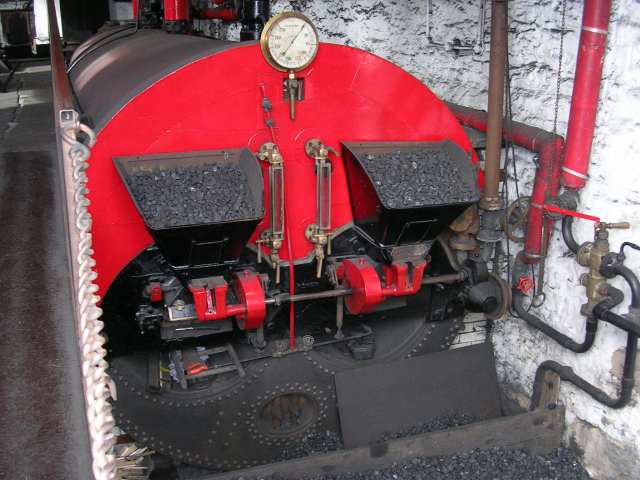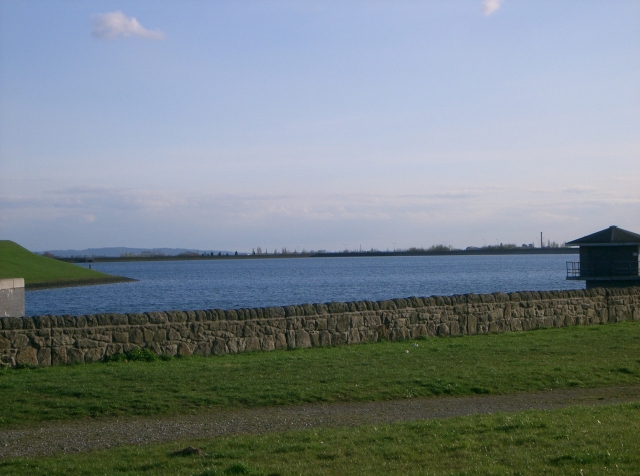|
Godley Reservoir
The Godley Reservoir is a reservoir in Godley, Greater Manchester, Godley, Hyde, Greater Manchester, Hyde, Greater Manchester. It was completed in 1851, as a critical part of the Longdendale Chain project that brings fresh water to Manchester. The Manchester Corporation Waterworks Act 1847 gave permission for the construction of the Woodhead Reservoir, Woodhead, Hollingworth Reservoir, Hollingworth and Arnfield Reservoir, Arnfield reservoirs, and the construction of a masonry aqueduct to convey drinking water from Arnfield and Hollingworth to a service reservoir at Godley. Water was captured from the River Etherow and stored in the great reservoirs and then flowed through the six-foot bore Mottram Tunnel to Godley. At Godley the water was filtered by passing it through straining frames made of oak and fine wires. It was Water chlorination, chlorinated to remove bacteria and then entered Manchester's water distribution network. This method was successfully used until the early 196 ... [...More Info...] [...Related Items...] OR: [Wikipedia] [Google] [Baidu] |
Godley, Greater Manchester
Godley is a suburb of Hyde, Greater Manchester, England. The area formed part of the municipal borough of Hyde in Cheshire from 1881 to 1974, when it became part of the metropolitan borough of Tameside.Vision of Britain - Godley parishVision of Britain - Hyde MB The earliest recorded agriculture in Tameside east of the River Tame was in Godley, from 1211–1249.Nevell (1991), p. 52. In 1851, Godle ... [...More Info...] [...Related Items...] OR: [Wikipedia] [Google] [Baidu] |
Manchester
Manchester () is a city in Greater Manchester, England. It had a population of 552,000 in 2021. It is bordered by the Cheshire Plain to the south, the Pennines to the north and east, and the neighbouring city of Salford to the west. The two cities and the surrounding towns form one of the United Kingdom's most populous conurbations, the Greater Manchester Built-up Area, which has a population of 2.87 million. The history of Manchester began with the civilian settlement associated with the Roman fort ('' castra'') of ''Mamucium'' or ''Mancunium'', established in about AD 79 on a sandstone bluff near the confluence of the rivers Medlock and Irwell. Historically part of Lancashire, areas of Cheshire south of the River Mersey were incorporated into Manchester in the 20th century, including Wythenshawe in 1931. Throughout the Middle Ages Manchester remained a manorial township, but began to expand "at an astonishing rate" around the turn of the 19th century. Manchest ... [...More Info...] [...Related Items...] OR: [Wikipedia] [Google] [Baidu] |
Photovoltaic Power Station
A photovoltaic power station, also known as a solar park, solar farm, or solar power plant, is a large-scale grid-connected photovoltaic power system (PV system) designed for the supply of merchant power. They are different from most building-mounted and other decentralised solar power because they supply power at the utility level, rather than to a local user or users. The generic expression utility-scale solar is sometimes used to describe this type of project. The solar power source is solar panels that convert light directly to electricity. However, this differs from and should not be confused with concentrated solar power, the other major large-scale solar generation technology, which uses heat to drive a variety of conventional generator systems. Both approaches have their own advantages and disadvantages, but to date, for a variety of reasons, photovoltaic technology has seen much wider use. , about 97% of utility-scale solar power capacity was PV. In some countries, ... [...More Info...] [...Related Items...] OR: [Wikipedia] [Google] [Baidu] |
United Utilities
United Utilities Group plc (UU), the United Kingdom's largest listed water company, was founded in 1995 as a result of the merger of North West Water and NORWEB. The group manages the regulated water and waste water network in North West England, which includes Cumbria, Greater Manchester, Lancashire, Merseyside, most of Cheshire and a small area of Derbyshire, which have a combined population of more than seven million. The United Utilities Group was the electricity distribution network operator for the North West until 2010, when its electricity subsidiary was sold to Electricity North West. United Utilities' headquarters are in Warrington, England, and the company has more than 5,000 direct employees. Its shares are listed on the London Stock Exchange and it is a constituent the FTSE 100 Index. North West England is the wettest region in England, and water hardness across the region is soft to very soft. History In 1989 the North West Water Authority, which was responsible ... [...More Info...] [...Related Items...] OR: [Wikipedia] [Google] [Baidu] |
Water Chlorination
Water chlorination is the process of adding chlorine or chlorine compounds such as sodium hypochlorite to water. This method is used to kill bacteria, viruses and other microbes in water. In particular, chlorination is used to prevent the spread of waterborne diseases such as cholera, dysentery, and typhoid. History In a paper published in 1894, it was formally proposed to add chlorine to water to render it "germ-free". Two other authorities endorsed this proposal and published it in many other papers in 1895. Early attempts at implementing water chlorination at a water treatment plant were made in 1893 in Hamburg, Germany. In 1897 the town of Maidstone, England was the first to have its entire water supply treated with chlorine. Permanent water chlorination began in 1905, when a faulty slow sand filter and a contaminated water supply caused a serious typhoid fever epidemic in Lincoln, England. Alexander Cruickshank Houston used chlorination of the water to stop the epidemic. ... [...More Info...] [...Related Items...] OR: [Wikipedia] [Google] [Baidu] |
River Etherow
The River Etherow is a river in northern England, and a tributary of the River Goyt. Although now passing through South Yorkshire, Derbyshire and Greater Manchester, it historically formed the ancient county boundary between Cheshire and Derbyshire. The upper valley is known as Longdendale. The river has a watershed of approximately , and the area an annual rainfall of . Course Rising in the Redhole Spring and Wike Head area of Pikenaze Moor in Derbyshire, the river broadens into the Longdendale Chain of reservoirs in the Peak District National Park. It emerges again in Tintwistle, Derbyshire, at the foot of Bottoms Reservoir dam and passes Melandra Castle in Gamesley, where it is joined by Glossop Brook.This brook takes in waters from the Shelf Brook, Hurst Brook and others. The Etherow enters the borough of Tameside at Hollingworth in Greater Manchester, passing into Stockport where it passes through Etherow Country Park. It flows into the River Goyt at Brabyns Park near ... [...More Info...] [...Related Items...] OR: [Wikipedia] [Google] [Baidu] |
Hollingworth Reservoir
Hollingworth Reservoir is a former reservoir near Hollingworth, Tameside, Greater Manchester. The reservoir straddles the Greater Manchester–Derbyshire border. It was constructed in 1854 as part of the Longdendale Chain, but was abandoned in 1987 and now forms part of the Swallows Wood nature reserve. See also * * Bottoms Reservoir ( ...[...More Info...] [...Related Items...] OR: [Wikipedia] [Google] [Baidu] |
Woodhead Reservoir
Woodhead reservoir is a man-made lake near the hamlet of Woodhead in Longdendale in north Derbyshire. It was constructed by John Frederick Bateman between 1847 and June 1877 as part of the Longdendale chain to supply water from the River Etherow to the urban areas of Greater Manchester. It is at the top of the chain of reservoirs and was the first to be started, though, due to construction problems, it was the last to be completed. Act of Parliament The Manchester Corporation Waterworks Act 1847 gave permission for the construction of the Woodhead and Arnfield reservoirs and the aqueduct of the Mottram Tunnel. The Manchester Corporation Waterworks Act 1848 allowed the construction of Torside and Rhodeswood Reservoir, and an aqueduct to convey the water from Rhodeswood to the Arnfield reservoir. These acts were important, as mill owners relied for their livings on water to power their mills and any potential reduction of supply was opposed. The acts guaranteed a flow of 121 mill ... [...More Info...] [...Related Items...] OR: [Wikipedia] [Google] [Baidu] |
Longdendale Chain
The Longdendale Chain is a sequence of six reservoirs on the River Etherow in the Longdendale Valley, in northern Derbyshire. They were constructed between 1848 and 1884 to a design by John Frederick Bateman to supply the growing population of Manchester and Salford with fresh water. The top three reservoirs (Woodhead, Torside and Rhodeswood) and Arnfield are for drinking water, and the lower reservoirs (Valehouse and Bottoms) are used as compensation reservoirs to maintain the downstream flow of the river. There was originally a seventh – Hollingworth Reservoir – which was abandoned in 1990, and has become part of the Swallows Wood nature reserve. p. 120. Water flowed by gravity through the Mottram Tunnel to the Godley covered reservoir where it drops to the service reservoirs at Denton, Audenshaw, Gorton and Prestwich. Reservoirs The reservoirs are listed from upstream to downstream i.e. from east to west: * Woodhead Reservoir * Torside Reservoir * Rhodeswood ... [...More Info...] [...Related Items...] OR: [Wikipedia] [Google] [Baidu] |
Greater Manchester
Greater Manchester is a metropolitan county and combined authority, combined authority area in North West England, with a population of 2.8 million; comprising ten metropolitan boroughs: City of Manchester, Manchester, City of Salford, Salford, Metropolitan Borough of Bolton, Bolton, Metropolitan Borough of Bury, Bury, Metropolitan Borough of Oldham, Oldham, Metropolitan Borough of Rochdale, Rochdale, Metropolitan Borough of Stockport, Stockport, Tameside, Trafford and Metropolitan Borough of Wigan, Wigan. The county was created on 1 April 1974, as a result of the Local Government Act 1972, and designated a functional Manchester City Region, city region on 1 April 2011. Greater Manchester is formed of parts of the Historic counties of England, historic counties of Cheshire, Lancashire and the West Riding of Yorkshire. Greater Manchester spans , which roughly covers the territory of the Greater Manchester Built-up Area, the List of urban areas in the United Kingdom, second most ... [...More Info...] [...Related Items...] OR: [Wikipedia] [Google] [Baidu] |
Hyde, Greater Manchester
Hyde is a town in Tameside, Greater Manchester, England, which had a population of 34,003 in 2011. Historically in Cheshire, it is northeast of Stockport, west of Glossop and east of Manchester. History Early history Newton Hall was present in the thirteenth century. The area formed a township of the parish of St Mary, Stockport. Its name is derived from the '' Hide'', a measure of land for taxation purposes, taken to be that area of land necessary to support a peasant family. In later times it was taken to be equivalent to . In the late 18th century the area that was to become the town centre was no more than a cluster of houses known as Red Pump Street. Gee Cross was much larger and 'Hyde' was still only used to refer to the estates of Hyde Hall on the banks of the River Tame. Altogether there were only 3,500 inhabitants in the district in 1801. The town is largely a creation of the 19th century and the Industrial Revolution. Industrial Revolution The population of Hyd ... [...More Info...] [...Related Items...] OR: [Wikipedia] [Google] [Baidu] |
Audenshaw
Audenshaw is a market town in Tameside, Greater Manchester, England, east of Manchester. Historically part of Lancashire, in 2011 it had a population of 11,419. The name derives from Aldwin, a Saxon personal name, and the Old English suffix ''shagh'' meaning "Woodland". Nico Ditch, an early-medieval linear earthwork possibly built as a defensive barrier against Vikings, runs through the area. Medieval Audenshaw was a division of the township of Ashton in the county of Lancashire. Audenshaw expanded as a centre for textile manufacture during the Industrial Revolution and the Victorian era with inhabitants employed in hat-making, cotton-spinning, calico-printing, and silk-weaving. In 1974, Audenshaw Urban District became part of the Metropolitan Borough of Tameside. History The name Audenshaw is a corruption of its earlier name ''Aldwinshagh'' which derives from Aldwin, a Saxon personal name, combined with the Old English suffix ''shagh'' meaning "Woodland".. Nico Ditch, a me ... [...More Info...] [...Related Items...] OR: [Wikipedia] [Google] [Baidu] |







